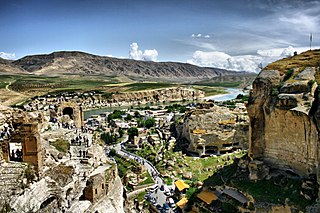
Baldwin II, also known as Baldwin of Bourcq or Bourg, was Count of Edessa from 1100 to 1118, and King of Jerusalem from 1118 until his death. He accompanied his cousins Godfrey of Bouillon and Baldwin of Boulogne to the Holy Land during the First Crusade. He succeeded Baldwin of Boulogne as the second count of Edessa when he left the county for Jerusalem following his brother's death. He was captured at the Battle of Harran in 1104. He was held first by Sökmen of Mardin, then by Jikirmish of Mosul, and finally by Jawali Saqawa. During his captivity, Tancred, the Crusader ruler of the Principality of Antioch, and Tancred's cousin, Richard of Salerno, governed Edessa as Baldwin's regents.

In the Battle of Azaz forces of the Crusader States commanded by King Baldwin II of Jerusalem defeated Aq-Sunqur al-Bursuqi's army of Seljuk Turks on 11 June 1125 and raised the siege of the town.
Ridwan was a Seljuk emir of Aleppo from 1095 until his death.

The Artuqid dynasty was a Sunni Muslim Turkoman dynasty originated from Döğer tribe that ruled in eastern Anatolia, Northern Syria and Northern Iraq in the eleventh through thirteenth centuries. The Artuqid dynasty took its name from its founder, Artuk Bey, who was of the Döger branch of the Oghuz Turks and ruled one of the Turkmen beyliks of the Seljuk Empire. Artuk's sons and descendants ruled the three branches in the region: Sökmen's descendants ruled the region around Hasankeyf between 1102 and 1231; Ilghazi's branch ruled from Mardin and Mayyafariqin between 1106 and 1186 and Aleppo from 1117–1128; and the Harput line starting in 1112 under the Sökmen branch, and was independent between 1185 and 1233.

The Danishmendids or Danishmends was a Turkoman beylik that ruled in north-central and eastern Anatolia from 1071/1075 to 1178. The dynasty centered originally around Sivas, Tokat, and Niksar in central-northeastern Anatolia, they extended as far west as Ankara and Kastamonu for a time, and as far south as Malatya, which they captured in 1103. In early 12th century, Danishmends were rivals of the Seljuk Sultanate of Rum, which controlled much of the territory surrounding the Danishmend lands, and they fought extensively against the Crusaders.
Najm ad-Din Ilghazi ibn Artuq was the Turkoman Artukid ruler of Mardin from 1107 to 1122. He was born into the Oghuz tribe of Döğer.

Hasankeyf is a town located along the Tigris, in the Hasankeyf District, Batman Province, Turkey. It was declared a natural conservation area by Turkey in 1981.
Abu'l-Faḍl (Abu'l-Hasan) ibn al-Khashshab was the Shi'i qadi and rais of Aleppo during the rule of the Seljuk emir Radwan.
Beylik of Dilmaç was a small principality in East Anatolia founded in the 11th century.
The Inalids was the name of a small beylik (principality) which reigned in a small territory around Amid between 1098–1183.
Sökmen was a Turkoman emir of the Seljuk Empire in the early 12th century.
Togan Arslan was a Turkish bey of the Beylik of Dilmaç.
Nizamettin Yağıbasan, or simply Yağıbasan was the sixth ruler of Danishmendids and the uncle of Melik Zünnun.

The timeline of the Principality of Antioch is a chronological list of events of the history of the Principality of Antioch.
Qasīm al-Dawla Sayf al-Dīn Abū Saʿīd Āqsunqur al-Bursuqī, also known as Aqsunqur al-Bursuqi, Aqsonqor il-Bursuqi, Aksunkur al-Bursuki, Aksungur or al-Borsoki, was the Seljuk Turkoman atabeg of Mosul from 1113–1114 and again from 1124–1126.
The Banu Munqidh, also referred to as the Munqidhites, were an Arab family that ruled an emirate in the Orontes Valley in northern Syria from the mid-11th century until the family's demise in an earthquake in 1157. The emirate was initially based in Kafartab before the Banu Munqidh took over the fortress of Shayzar in 1081 and made it their headquarters for the remainder of their rule. The capture of Shayzar was the culmination of a long, drawn-out process beginning with the Banu Munqidh's nominal assignment to the land by the Mirdasid emir of Aleppo in 1025, and accelerating with the weakened grip of Byzantine rule in northern Syria in the 1070s.
The siege of Aleppo by Baldwin II of Jerusalem and his allies lasted from 6 October 1124 to 25 January 1125. It ended in a Crusader withdrawal following the arrival of a relief force led by Aqsunqur al-Bursuqi.
Bahram al-Da'i or Bahram of Astarabad was a 12th-century Persian Nizari Ismaili who was the Chief Da'i and leader of the Assassins in Syria from after 1113 through 1128. Although his attempt to establish a Nizari base in Damascus was unsuccessful, he had an important role in organizing Nizari presence in Northern and Southern Syria.
Husam al-Din Timurtash was an Artuqid emir of Mardin (1122–1154) and ruler of Aleppo (1124–1125).
Sultan Shah ibn Radwan was the last Seljuk sultan of Aleppo from 1114 to 1118, son of Ridwan, Emir of Aleppo.







